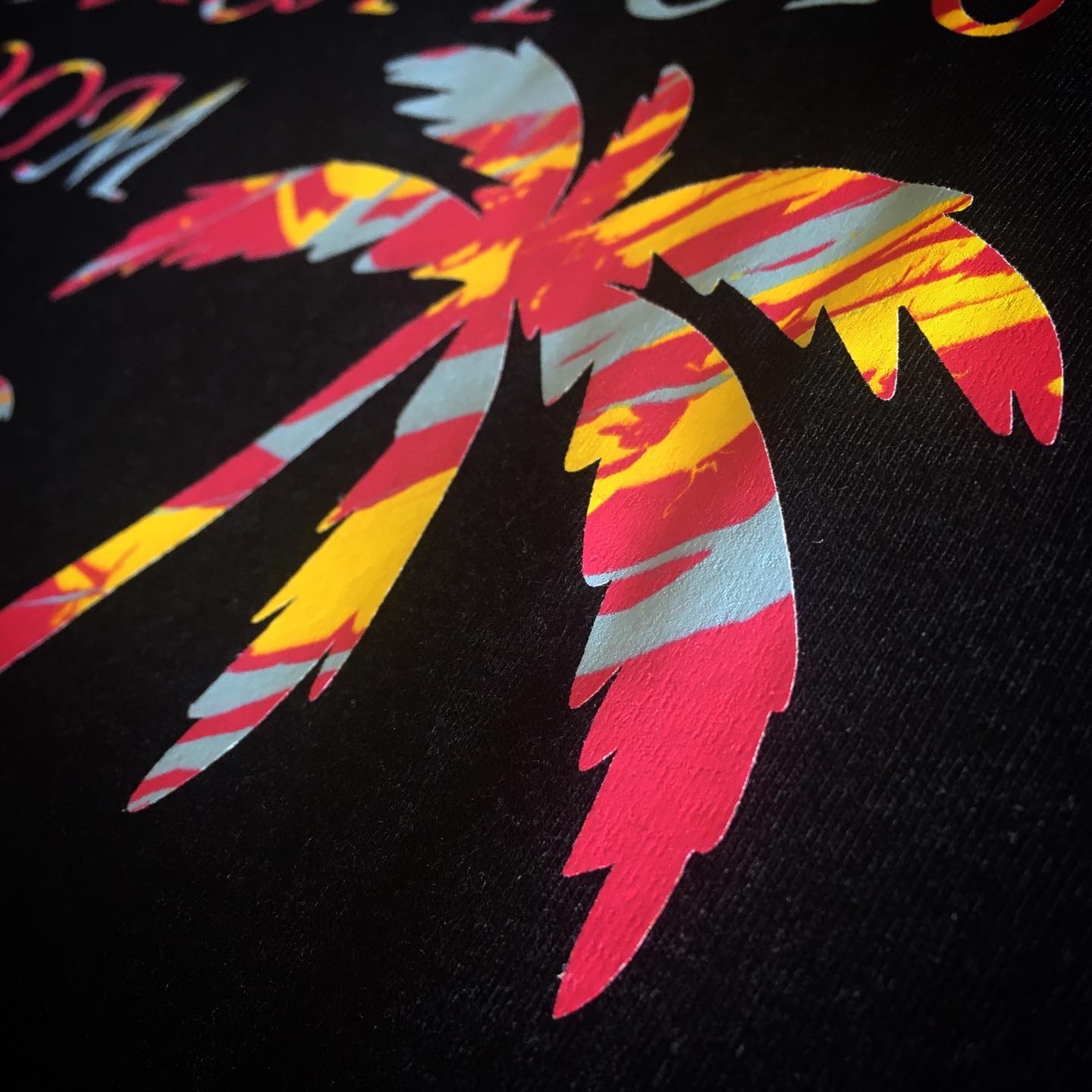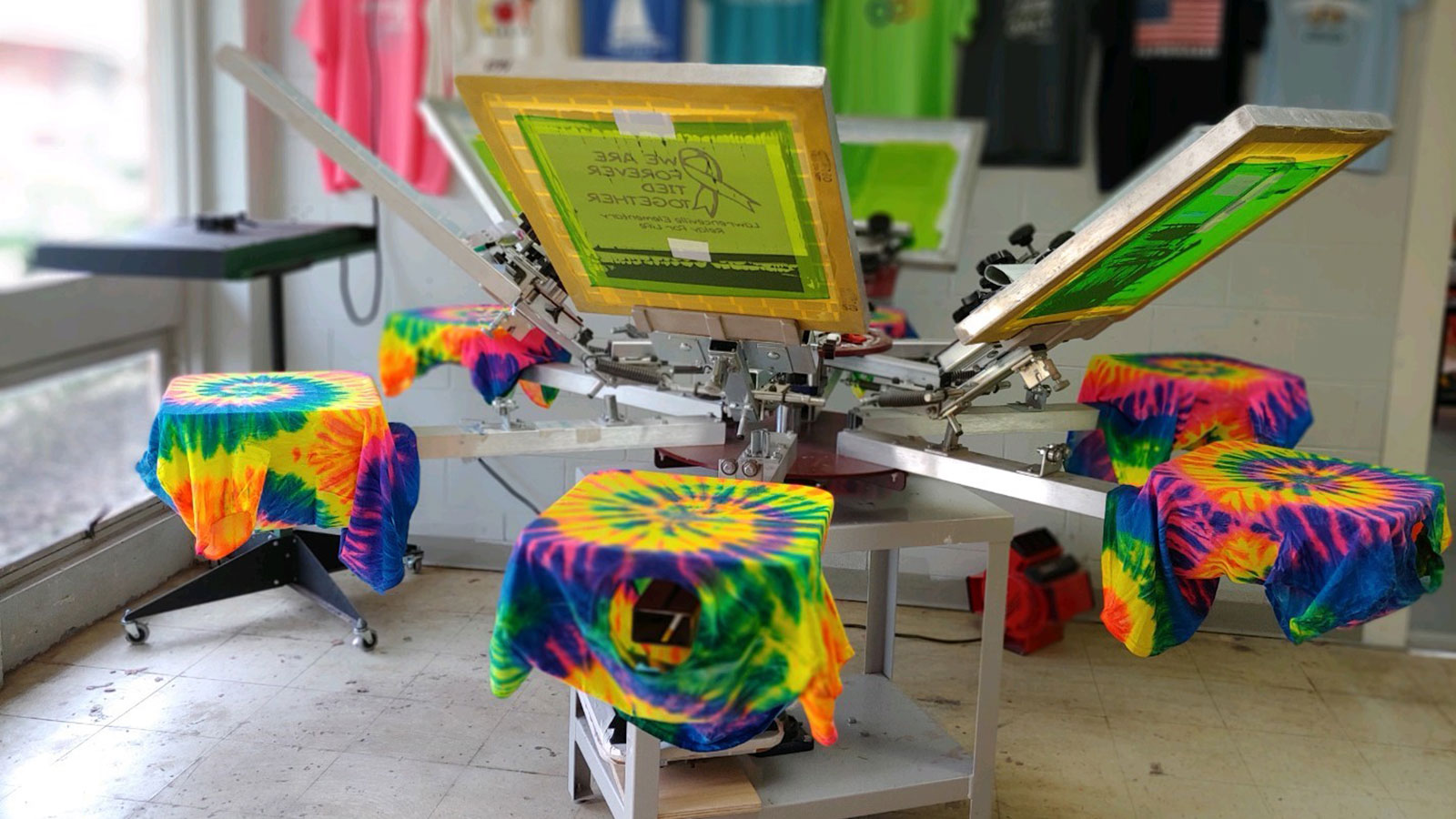Detailed Silk Screen Printing for Custom Art Apparel
Detailed Silk Screen Printing for Custom Art Apparel
Blog Article
Display Printing Uncovered: Every Little Thing You Need to Learn About Tee Shirt and Garment Printing Strategies
If you have actually ever before wondered how those dynamic designs wind up on your favorite t-shirts, you're in the best place. Screen printing is a fascinating technique that incorporates art with strategy, offering limitless opportunities for creativity. Comprehending the basics, from tools to ink choices, can substantially impact your outcomes. All set to discover the important elements that make display publishing an art type? Let's uncover the information that can raise your tasks.
The Basics of Display Printing: Exactly How It Functions
When you plunge right into display printing, you'll discover it's both a science and an art. At its core, screen printing includes developing a pattern, or display, that permits ink to travel through just in specific locations (screen printing kit). You start by picking your layout and preparing your screen with a light-sensitive emulsion. As soon as you expose this solution to light, it solidifies, leaving your layout as an unfavorable room.
Following, you'll blend your inks and prepare your printing surface area. Setting the screen over the material, after that utilize a squeegee to press ink through the display onto the garment. This process needs precision, as you desire clear, lively prints. After printing, you'll heal the ink with warm, ensuring it complies with the textile and lasts via washes. Each step is important, and grasping them will certainly elevate your screen printing skills, transforming easy garments into distinct, expressive items.
Types of Display Printing Techniques
Once you comprehend the essentials of display printing, it's time to explore the various techniques that can raise your layouts. One preferred method is standard screen printing, where ink is pressed through a stenciled display.
One more choice is plastisol printing, recognized for its sturdiness and vivid shades, making it a preferred for many brand names. Experiment with halftone printing to produce gradient effects and intricate designs.
Vital Devices for Display Printing
To accomplish sensational cause screen printing, having the appropriate tools is basic. First, you'll need a strong screen printing framework, which holds the mesh that moves your style onto the garment. Next, spend in premium squeegees; these are crucial for applying ink equally across the screen. You'll also require a good exposure device to produce your screens, along with a washout cubicle for cleaning them after use. A reputable warmth resource, like a conveyor dryer or warm press, is essential for curing your prints to ensure long life. Don't forget a correct office, equipped with tables and storage for your materials. Finally, safety equipment, such as handwear covers and masks, will certainly keep you safe from chemicals and inks. With the right tools, you'll be well on your means to creating professional-quality prints.
Selecting the Right Inks and Materials
When choosing inks and materials for screen printing, you need to take into consideration the kind of ink that functions finest for your job. Consider material compatibility to guarantee your designs look terrific and last long. Also, explore environmentally friendly ink choices to make your printing process more lasting.
Sorts Of Screen Inks
Picking the right screen ink is crucial for accomplishing vivid, durable prints that satisfy your task's needs. There are a number of kinds of display inks to analyze. Specialty inks, such as metal or glow-in-the-dark, can include one-of-a-kind results to your layouts.

Fabric Compatibility Considerations
Understanding textile compatibility is crucial for achieving high-quality display prints, especially considering that different products react distinctly to various inks. Constantly evaluate your inks on example fabric to assure they adhere effectively and preserve shade integrity. In addition, keep in mind that textile weight and structure can influence the final end result, so selecting the right ink and material combo is essential for your job's success.
Eco-Friendly Ink Options
Environment-friendly inks are ending up being a popular choice for display printers that intend to decrease their ecological influence while preserving high quality. When selecting inks, consider water-based inks, which are much less unsafe and much easier to tidy up contrasted to standard solvents. These inks bond well with fabrics, supplying dynamic results without toxic chemicals. You could likewise discover eco-solvent inks that use fewer unpredictable organic substances (VOCs), making them a much safer choice for both your health and the world.
Furthermore, look for inks made from renewable sources, such as soy or vegetable-based choices. By choosing the appropriate inks and products, you'll not just develop stunning layouts yet additionally add to a much more sustainable printing process. Make the switch, and your prints will reflect your commitment to the setting!
Preparing Your Layout for Display Printing

File Format Needs
To ensure your style looks lively and sharp on textile, you'll need to pay close focus to file style requirements for screen printing. Make certain your layout has a clear history to prevent unwanted white edges on your prints. Keep color settings in mind; CMYK is standard for screen printing, so transform your RGB makes accordingly.
Color Separation Methods
Shade separation is a crucial step in preparing your design for screen printing, and grasping it can considerably improve your print top quality. You'll require to break your design right into individual colors, as each shade calls for a different screen during printing. Beginning by recognizing all the shades in your style and create layers each. You can make use of software program like Adobe Photoshop or Illustrator to separate and separate colors successfully. Be particular to conserve each layer as a different documents, generally in a style like TIFF or PSD. This accuracy not just guarantees exact color depiction yet also enhances the printing process. By taking notice of color separation, you'll attain professional and vibrant cause your screen-printed garments.
Resolution and Dimension
Accomplishing the finest outcomes in screen printing begins with ensuring your design has the ideal resolution and size. Preferably, your artwork ought to go to least 300 DPI (dots per inch) for sharp, clear prints. If you utilize reduced resolution, your end product might look less than professional and pixelated.
When it concerns dimension, consider the measurements of your print location. Design your art work to match the last print size, preferably creating it in the real measurements you'll be printing. In this manner, you'll stay clear of any type of unexpected scaling issues.
Constantly inspect your design in both vector and raster formats. Vector graphics can be scaled without shedding high quality, making them suitable for display printing. Preparing properly will assure your style looks incredible on every garment!
Step-by-Step Display Printing Process
Display printing is a vibrant procedure that enables you to develop vivid layouts on numerous surface areas. To get begun, you'll require a screen, emulsion, and your picked ink.
After cleaning out the unexposed solution, your screen is ready. Set it up on your printing surface area and straighten your garment under it. Put ink onto the display and use a squeegee to push the ink via the stencil onto the textile. Raise the screen carefully and allow the print completely dry. Ultimately, treat the ink making use of warm to assure toughness. That's it! You have actually effectively screen printed your design.
Tips for Effective Screen Printing Projects
While you're diving right into your screen printing jobs, keep in mind that preparation is page essential to success. Start by gathering all your go right here materials-- inks, screens, squeegees, and garments. A tidy office helps protect against unwanted mistakes, so clean prior to you start.
Next, confirm your art work is high-resolution and effectively sized for your garment. Evaluate your display for proper exposure and tidy it thoroughly to prevent spots. When mixing your inks, comply with the manufacturer's guidelines to attain the best uniformity.
Throughout printing, apply even stress with your squeegee for consistent results. Do not rush; take your time to confirm each print fulfills your standards. After printing, let your garments completely dry entirely before handling or packaging them.
Finally, always maintain a sample of your benefit future recommendation. By doing this, you can analyze your development and improve your strategies in time. Satisfied printing!

Frequently Asked Inquiries
The length of time Does It Take to Set up a Display Printing Work?
Establishing a display printing work typically takes about half an hour to an hour. You'll prepare the screens, mix inks, and readjust journalism. The moment differs based upon intricacy and experience, so remain organized!
Can I Print on Various Textile Keys In Making Use Of the Same Strategy?
Yes, you can publish on different fabric kinds utilizing the same strategy, but you'll require to change your inks and setups. Some textiles take in ink in different ways, so exploring warranties the finest outcomes for each and every material.
What Prevail Errors to Stay Clear Of in Display Printing?
When screen printing, stay clear of usual errors like making use of the incorrect ink, overlooking appropriate direct exposure times, or missing pre-press checks. Always evaluate your arrangement and keep tidy screens to guarantee quality outcomes each time.
Exactly How Can I Appropriately Tidy and Maintain My Display Printing Equipment?
To correctly clean and preserve your screen printing equipment, you ought to regularly wash screens with suitable solvents, examine squeegees for wear, and ensure all devices are stored dry and dust-free. Uniformity avoids pricey repair services and boosts performance.
Is Display Printing Eco-friendly Contrasted to Other Approaches?
Screen printing can be more eco friendly than various other approaches, especially if you use eco-conscious products and water-based inks. By picking sustainable supplies and techniques, you decrease waste and minimize your effect on the earth.
Screen Printing Uncovered: Whatever You Required to Know Regarding Tee Shirt and Garment Printing Techniques
At its core, screen printing entails producing a stencil, or display, that enables ink to pass through just in specific locations. Placement the screen over the fabric, after that make use of a squeegee to push ink with the display onto the garment. One preferred approach is traditional screen printing, where ink is pressed through a stenciled screen.When selecting inks and products for display printing, you need to take into account the type of ink that works best for your project.
Report this page